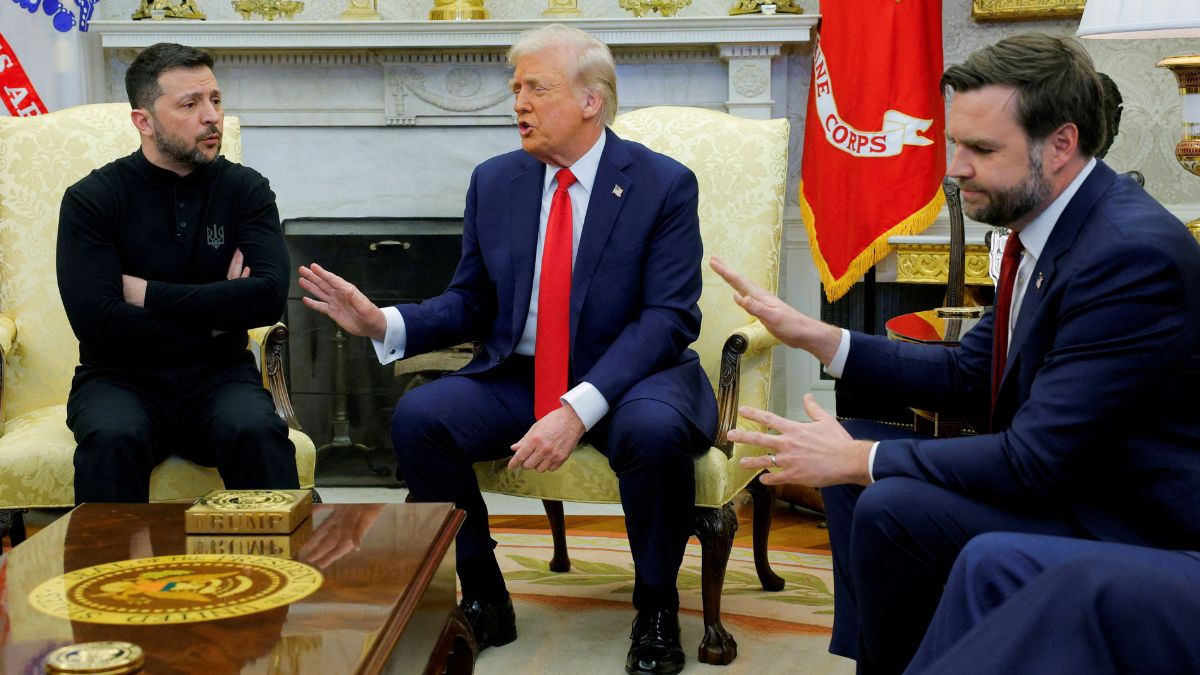United States Vice President JD Vance took centre stage during a tense Oval Office meeting between President Donald Trump and Ukrainian President Volodymyr Zelenskyy last week, marking a dramatic moment in US-Ukraine relations.
While the meeting began on a cordial note, Vance’s sharp criticisms of Zelenskyy ignited a political firestorm, demonstrating the vice president’s increasingly assertive role in US foreign policy.
During the exchange, Vance lauded Trump for his efforts toward what he termed a “diplomatic solution” to the Ukraine-Russia conflict. Zelenskyy, who has opposed direct negotiations between Washington and Moscow, challenged this approach, prompting a heated response from Vance .
“I’m talking about the kind of diplomacy that’s going to end the destruction of your country,” Vance told Zelenskyy. “Mr. President, with respect, I think it’s disrespectful for you to come into the Oval Office to try to litigate this in front of the American media.”
Vance also accused Zelenskyy of influencing US elections, referencing the Ukrainian leader’s visit to a Pennsylvania munitions factory and his meeting with Trump’s 2024 opponent, Kamala Harris.
His remarks earned praise from conservative lawmakers, with Senator Lindsey Graham stating, “I was very proud of JD Vance standing up for our country,” and suggesting that Zelenskyy should step down.
Meanwhile, Alabama Senator Tommy Tuberville referred to Zelenskyy as “that Ukrainian weasel,” while Congressman Mike Lawler called the meeting a “missed opportunity for both the United States and Ukraine.”
The confrontation, broadcast globally, led to the abrupt cancellation of the remainder of Zelenskyy’s White House visit.
Vance’s confrontation with Zelenskyy is emblematic of the broader shift in the Trump administration’s stance on Ukraine. The US vice president has long been sceptical of continued US military aid, echoing sentiments he expressed in 2022 when he told a podcast, “I don’t really care what happens to Ukraine one way or the other.”
Following the Oval Office clash, White House officials began briefing reporters that Trump’s team was reconsidering its military assistance to Kyiv.
Some sources claim the incident was not premeditated, but others suggest that Vance is deliberately shaping a more isolationist US foreign policy.
Vance becoming Trump’s political brawler
Unlike past vice presidents who largely played supporting roles, Vance has actively engaged in foreign policy, often taking a more aggressive stance than Trump himself. His controversial remarks at the Munich Security Conference last month further highlighted his ideological battle with European leaders.
At the conference, Vance accused European governments of stifling free speech and failing to manage immigration, declaring, “If you’re running in fear of your own voters, there is nothing America can do for you.”
The speech drew criticism from European Union officials, with Kaja Kallas, the EU’s foreign policy chief, responding, “They try to pick a fight with us, and we don’t want to pick a fight with our friends.”
His remarks in Munich also aligned with his criticism of UK Prime Minister Keir Starmer during a separate Oval Office meeting, where Vance challenged the British leader over free speech regulations. Starmer pushed back, asserting, “We’ve had free speech for a very, very long time in the United Kingdom, and it will last for a very, very long time.”
These high-profile confrontations signal that Vance is carving out a unique role within the Trump administration, one that goes beyond the traditional duties of a vice president.
Vance faces protests in during family trip to Vermont
In the wake of the Oval Office incident, Vance became the target of protests , particularly during a family ski trip to Vermont. Demonstrators lined the streets near Sugarbush Resort in Warren, holding signs in support of Ukraine.
Some protesters also waved Palestinian flags and carried messages supporting immigrant rights, turning the event into a broader critique of the Trump administration’s policies.
One protester, Tekla Van Hoven, voiced her frustration, telling WCAX-TV, “Ski Russia because JD Vance has no friends in Vermont, but he’s got lots of friends in Russia, so he should go there for vacation.”
Although the demonstrations were mostly peaceful, they reflected the growing dissatisfaction with the Trump administration’s evolving stance on Ukraine.
Vermont Governor Phil Scott issued a statement urging residents to respect Vance’s visit, stating, “I hope Vermonters remember the vice president is here on a family trip with his young children and, while we may not always agree, we should be respectful.”
A smaller group of Trump and Vance supporters organised a counter-rally, showing their backing for the administration’s “America First” approach.
Vance’s future ambitions
Vance’s increasing involvement in foreign policy raises questions about his future ambitions. Trump recently stated in a Fox News interview that it was “too early” to determine whether Vance would be his successor in 2028.
However, Vance’s assertiveness in shaping the administration’s foreign policy suggests he is positioning himself as a major force in the Republican Party.
What is clear, however, is that Vance is not content with being a mere understudy — he is actively reshaping America’s global strategy, one confrontation at a time.
Also Watch:
With inputs from agencies
)